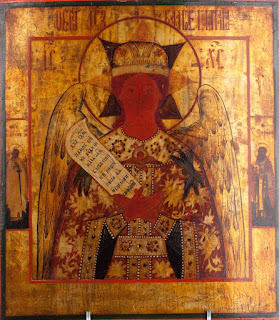The Only Begotten Son Icon
Today, we'll discuss the icon of the Only Begotten Son.
The above icon is from Nevyansk, a famous Old Believer icon painting town, known for its more elaborate and ornate icons.
Examples of these types of icons go back to at least the 16th century, but probably further. The components of the icon are mostly ancient in origin.
This is a hymnographical-allegorical depiction of the Father and the Holy Spirit. The Father has two angels to either side, and holds his fingers in the two-finger sign of the cross. As I have discussed, this depiction is canonical.
Here, we have an angel bearing on each side a moon, demonstrating the eclipse that occurred during the Crucifixion. The other angels hold orbs with Сть, standing for Спаситель, meaning Savior.
This is an image of the Holy Trinity, at a focal point of the icon - here, the viewer looks at the Holy Trinity with reverence.
This is the icon of the Theotokos of the Sign. It is rather common as an icon, and further establishes the Incarnation in the viewer's mind. The text below reads (I have written it below in modern Russian orthography, but in Old Church Slavonic language): Всплтитиия отитыя Богородицы и приснодевы Марии непреложно вчлевечивыйся.
This is a praising of the Theotokos - it mentions her ever-virginity, sacrosanctness and inviolability.
This is a depiction of the Crucifixion. The text reads: Распятия Христе Боже императию насмерть наступи.
It states: The Crucifixion of Christ our God, conquers and treads upon death. (Rough translation).
This is the central image of the icon. It is of Christ Emmanuel, emphasizing His eternal nature and Divine Filiality. Angels hold a banner above Him, reading: Единоро Дныи сыне илово божие безсмертен сый.
This essentially means "The Only Begotten Son, immortal God.
This is an image of Christ as Emperor and King: Next to Him we see one of His angels attacking and conquering a fiery pit, representing Death and Hell. This emphasizes Christ as King and Conqueror.
This shows the relationship of the Theotokos to Him, as mother even to the Crucifixion. This is a classic image in iconography, and represents Christ's lying in the tomb.
This final image, in the bottom right corner, is of a symbol of Death holding the bitter cup. It comes for all, holy nuns and priests and monks and bishops, and all must be prepared for judgement.
More examples of this icon:
















Comments
Post a Comment